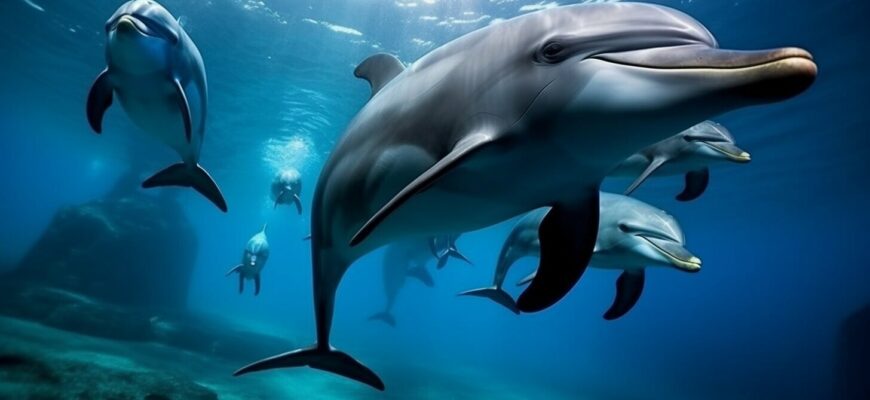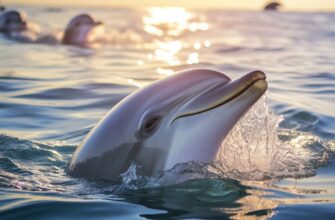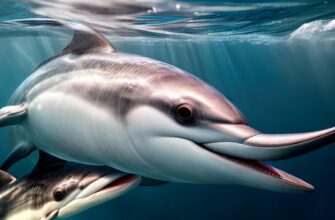Have you ever wondered how dolphins manage to breathe while exploring the depths of the ocean? These fascinating creatures have a unique respiratory system that allows them to thrive in their underwater habitat. In this article, we’ll explore the complex mechanisms behind dolphin respiration and shed light on some common misconceptions about how they breathe.
- Key Takeaways
- Dolphin Respiratory System: A Complex Mechanism
- Dolphin Respiratory System: Adaptations for Underwater Breathing
- The Process of Dolphin Breathing: How They Get Oxygen
- Do Dolphins Have Gills? The Truth Revealed
- Underwater Breathing Techniques: How Do Dolphins Hold Their Breath?
- Survival Strategies: How Do Dolphins Thrive Underwater?
- Efficient Swimming Techniques
- Social Behaviors
- Hunting Tactics
- Conclusion
- FAQ
- Q: How do dolphins breathe?
- Q: What is the respiratory system of dolphins like?
- Q: How do dolphins obtain oxygen?
- Q: Do dolphins have gills?
- Q: How do dolphins hold their breath underwater?
- Q: How do dolphins survive underwater?
Key Takeaways
- Dolphins have a complex respiratory system that enables them to breathe efficiently while swimming or diving.
- They do not have gills like fish and rely on their unique adaptations to obtain oxygen from the atmosphere.
- Dolphins are capable of holding their breath for extended periods underwater due to their physiological and behavioral adaptations.
- Their ability to thrive in an aquatic environment is a testament to their remarkable intelligence and adaptation skills.
Dolphin Respiratory System: A Complex Mechanism
Dolphins have a remarkable respiratory system that allows them to breathe efficiently while swimming or diving. Their unique adaptations for underwater breathing are vital for their survival in aquatic environments. Let’s take a closer look at the complex mechanism of the dolphin respiratory system.
Like all mammals, dolphins have lungs, which they use to exchange gases with the atmosphere. However, unlike land mammals that breathe through their nose or mouth, dolphins use a blowhole on top of their head to take in air and release carbon dioxide. This blowhole is connected to their respiratory system and acts as a one-way valve to prevent water from entering their lungs.
| Dolphin Respiratory System | |
|---|---|
| Blowhole | One-way valve to prevent water from entering lungs |
| Lungs | Exchange gases with the atmosphere |
| Diaphragm | Helps with breathing by expanding and contracting lungs |
In addition to their blowhole and lungs, dolphins also have a diaphragm, which helps with breathing. This unique muscular structure expands and contracts the lungs, allowing the dolphin to take in oxygen and release carbon dioxide. The diaphragm is especially important for deep diving, as it allows the dolphin to control its buoyancy and stay underwater for extended periods.
Dolphin Respiratory System: Adaptations for Underwater Breathing
Dolphins have several adaptations that allow them to breathe underwater for extended periods. These include a high oxygen-carrying capacity in their blood, the ability to store oxygen in their muscles, and the ability to slow their heart rate while diving to conserve oxygen.
When a dolphin dives underwater, its oxygen consumption decreases, and its heart rate slows down, which helps to conserve oxygen. Additionally, dolphins can redirect blood flow to their vital organs, such as the heart and brain, while reducing blood flow to less-important organs like the skin and muscles.
The dolphin respiratory system is truly remarkable and allows these aquatic mammals to thrive in their underwater habitat. Understanding the intricacies of their respiratory system is essential for conservation efforts and the continued survival of these intelligent creatures.
The Process of Dolphin Breathing: How They Get Oxygen
Unlike fish, dolphins do not have gills and cannot extract oxygen directly from water. Instead, they have adapted to breathe air while submerged, using a series of specialized respiratory structures.
When a dolphin surfaces, it opens its blowhole, located on the top of its head, and takes in a deep breath of air. The blowhole then closes, and the inhaled air is directed to the lungs.
While underwater, the dolphin can hold its breath for several minutes. The length of time varies depending on activity level, with diving dolphins holding their breath longer than those at the surface. To maximize oxygen conservation, a diving dolphin will slow its heart rate, reducing its oxygen consumption and extending its dive time.
When the dolphin needs to expel carbon dioxide and take in another breath of air, it will surface and repeat the process.
Overall, the process of dolphin breathing is a complex and fascinating adaptation that allows these aquatic mammals to thrive in their underwater environment.
Do Dolphins Have Gills? The Truth Revealed
It’s a common misconception that dolphins have gills, like fish do. However, dolphins are mammals, and like all mammals, they breathe air with lungs. Dolphins have developed unique respiratory adaptations that allow them to breathe efficiently while submerged in water.
Unlike fish, dolphins don’t extract oxygen from water using gills, which are specialized organs that fish use to extract oxygen from water. Instead, dolphins breathe air through their nostrils, known as blowholes, located on the top of their heads.
When dolphins surface to breathe, they exhale through their blowholes, expelling old air and any carbon dioxide from their lungs. They then inhale fresh air, taking in as much oxygen as possible before diving back underwater.
While dolphins don’t have gills, they are supremely adapted to their aquatic environment, possessing a host of unique features that enable them to thrive underwater. Their streamlined bodies and powerful tails allow them to swim efficiently, while their highly social behavior and hunting tactics allow them to work together to catch prey.
In sum, dolphins are remarkable creatures that have evolved a host of adaptations to survive in an underwater world. Although they don’t have gills like fish, their unique respiratory system allows them to extract oxygen from the air and thrive in a variety of aquatic environments.
Underwater Breathing Techniques: How Do Dolphins Hold Their Breath?
Dolphins are well-known for their impressive ability to hold their breaths underwater. While humans are limited to a few minutes of submersion before requiring air, dolphins can remain underwater for up to 20 minutes at a time. This remarkable feat is due to their unique physiological and behavioral adaptations.
Physiologically, dolphins have several adaptations that allow them to conserve oxygen and extend their dive times. For instance, they have a larger volume of blood and greater concentrations of myoglobin, a protein that stores oxygen in muscles. Additionally, their lungs are highly flexible, allowing them to collapse completely to avoid nitrogen absorption during deep dives and then rapidly reinflate upon surfacing.
Behaviorally, dolphins are able to limit their oxygen consumption by slowing their heart rate and conserving energy while submerged. They also strategically time their dives to coincide with the most oxygen-rich parts of the water column and may engage in deep dives only when necessary, such as during hunting or evading predators.
Survival Strategies: How Do Dolphins Thrive Underwater?
When it comes to surviving underwater, dolphins have developed a range of strategies that allow them to thrive in their marine habitats. These strategies include efficient swimming techniques, social behaviors, and hunting tactics that enable them to adapt to their environment and outmaneuver their prey. Here are some of the ways dolphins survive and thrive underwater:
Efficient Swimming Techniques
Dolphins are incredibly fast swimmers, capable of reaching speeds of up to 37 miles per hour. They achieve this speed by using their powerful tail flukes and streamlined bodies to glide through the water with minimal resistance. In addition, dolphins are known for their ability to perform acrobatic feats such as breaching, porpoising, and tail-slapping, which they use to evade predators and communicate with one another.
Social Behaviors
Dolphins are highly social animals that form close bonds with one another. They live in complex societies and communicate with each other using a range of clicks, whistles, and body language. These social bonds allow dolphins to work together to hunt for food, protect one another from predators, and care for their young.
Hunting Tactics
Dolphins are skilled hunters that use a variety of tactics to catch their prey. Some species of dolphins, such as the bottlenose dolphin, work together in groups to herd schools of fish into compact balls, making them easier to catch. Other species, such as the killer whale, hunt larger prey such as seals and sea lions, using their powerful jaws and teeth to subdue their prey.
Overall, the ability of dolphins to thrive in their underwater habitat is a testament to their remarkable adaptability and intelligence. By employing a range of survival strategies, they are able to navigate their marine environment with ease and outmaneuver their prey, making them one of the most successful and fascinating creatures in the animal kingdom.
Conclusion
After delving into the world of dolphin respiration, it’s clear that these aquatic mammals are truly remarkable creatures. Their complex respiratory system and unique adaptations allow them to thrive in marine environments, where other mammals would struggle to survive.
We’ve learned that dolphins breathe air through their blowholes, utilizing their lungs to extract oxygen from the atmosphere. They’re able to hold their breath for extended periods thanks to physiological and behavioral adaptations that enable them to conserve oxygen, such as slowing their heart rate and swimming slowly.
Contrary to popular belief, dolphins do not have gills and are not fish but mammals. Their remarkable respiratory system enables them to obtain oxygen underwater, but they still need to resurface periodically to breathe.
While their breathing techniques are critical to their survival, it’s also worth highlighting their efficient swimming techniques, social behaviors, and hunting tactics, which all contribute to their successful adaptation to the marine environment.
Overall, learning about dolphin respiration has emphasized the incredible nature of these creatures and the importance of preserving their marine habitats. Let’s continue to appreciate and protect these intelligent and fascinating animals for generations to come.
FAQ
Q: How do dolphins breathe?
A: Dolphins breathe by utilizing their blowholes on the tops of their heads. When they surface, they exhale stale air and inhale fresh oxygen through their blowholes. This efficient mechanism allows them to breathe without interrupting their swimming or diving activities.
Q: What is the respiratory system of dolphins like?
A: The respiratory system of dolphins is highly complex. It involves lungs, trachea, bronchi, and bronchioles, similar to terrestrial mammals. However, their respiratory system is adapted to efficiently exchange gases underwater, allowing them to thrive in aquatic environments.
Q: How do dolphins obtain oxygen?
A: Dolphins obtain oxygen by inhaling air through their blowholes. When they surface, they quickly exhale stale air and inhale fresh oxygen. The oxygen is then transported through their respiratory system to the bloodstream, providing the necessary oxygen for their vital body functions.
Q: Do dolphins have gills?
A: No, dolphins do not have gills. They are mammals and rely on lungs for respiration, similar to humans. While they can hold their breath for extended periods, they need to return to the surface to breathe in fresh oxygen.
Q: How do dolphins hold their breath underwater?
A: Dolphins have adapted to hold their breath underwater by slowing down their heart rate and conserving oxygen. They can close their blowholes tightly, preventing water from entering. Additionally, dolphins have a high capacity for oxygen storage in their blood and muscles, allowing them to extend their dive times.
Q: How do dolphins survive underwater?
A: Dolphins employ various survival strategies to thrive in their underwater habitat. Their streamlined bodies and powerful tails enable efficient swimming. They also utilize social behaviors and cooperative hunting techniques to increase their chances of finding food. All these adaptations contribute to their successful survival in the marine environment.







